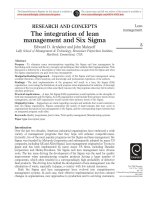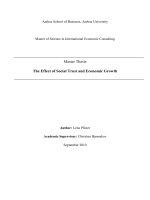the dynamics of poverty a review of decomposition approaches and application to data from burkina faso
Bạn đang xem bản rút gọn của tài liệu. Xem và tải ngay bản đầy đủ của tài liệu tại đây (240.69 KB, 14 trang )
<span class='text_page_counter'>(1)</span><div class='page_container' data-page=1>
<b>The Dynamics of Poverty: A Review of Decomposition </b>
<b>Approaches and Application to Data From Burkina Faso </b>
Tambi Samuel KABORE
UFR-SEG-Université de Ouagadougou
Adresse : 01 BP 6693 Ouaga 01
Email :
<b>Abstract</b> Recent years have been characterized by significant efforts to understand and
fight poverty, especially in Africa. Decomposing the dynamics of poverty is one of the
focuses of this analysis, which seeks to evaluate the contribution some major factors
make to the evolution of the phenomenon of poverty. Several approaches to this
decomposition have been proposed in the literature. Our study draws on the Shapley
value as a theoretical foundation for various decompositions and reviews the primary
methods in existence. These methods are illustrated using data from Burkina Faso. This
work was conducted with technical support from CREFA at the Université Laval and
provides a framework for advanced training sessions jointly conducted by SISERA and
the WBI.
</div>
<span class='text_page_counter'>(2)</span><div class='page_container' data-page=2>
<b>1 I</b>
<b>NTRODUCTION</b>
The phenomenon of poverty is very pervasive in Africa. For example, the incidence of
poverty rose from 30 per cent in 1985 to 46 per cent in 1988 in Côte d’Ivoire (Grootaert,
1996), from 44.5 per cent in 1994 to 45.3 per cent in 1998 in Burkina Faso (INSD, 1996,
2000), and from 48 per cent in 1994 to 52.9 per cent in 1997 in Kenya (Greda et al.,
2001)—demonstrating both the extent of the problem and a worsening trend.
Recent years have been characterized by a significant effort in terms of research aimed at
understanding this phenomenon. Moreover, various African countries have elaborated
<i>Poverty Reduction Strategy Papers (PRSP)</i> under the aegis of the World Bank. Among
the methods for fighting poverty, economic growth and income redistribution using a
variety of mechanisms occupy a central position. The intertemporal evolution of poverty,
and particularly its decomposition into growth, redistribution, and sectorial effects is of
vital importance to researchers, donors, and political decision makers.
This document examines this decomposition of poverty and seeks to present the existing
methods for decomposing the intertemporal evolution of poverty.
This work is part of the training activities jointly conducted by SISERA, the WBI, and
CREFA aimed at familiarizing researchers and African decision-makers with the tools of
poverty analysis.
<b>2 R</b>
<b>EVIEW OF THE </b>
<b>L</b>
<b>ITERATURE</b>
<b>2.1 </b> <b>AN OVERVIEW OF THE DECOMPOSITION ISSUE </b>
</div>
<span class='text_page_counter'>(3)</span><div class='page_container' data-page=3>
A general overview of the decomposition issue is presented by Shorrocks (1999) as
follows. Let <i>I</i> be an aggregate indicator representing a poverty or inequality measure, and
let <i>X<sub>k</sub></i>,<i>k</i> =1,2,<sub>K</sub>,<i>m</i> be a set of factors contributing to the value of <i>I</i>. We can write
(
<i>X</i><sub>1</sub>,<i>X</i><sub>2</sub>, <i>X<sub>m</sub></i>)
,<i>f</i>
<i>I</i> = <sub>K</sub> (1)
where is an appropriate aggregation function. The goal of all decomposition
techniques is to attribute contributions, <i>C</i> , to each of the factors, , so that, ideally,
the value of <i>I</i> will be equal to the sum of the <i>m</i> contributions.
( )
⋅<i>f</i>
<i>k</i> <i>Xk</i>
( )
<i>P</i><i>P</i>
<i>X</i>
Each of the decomposition techniques, whether static or dynamic, yields a particular
solution to this general decomposition problem as a function of the characteristics of <i>I</i>
and the goals of the decomposition. To illustrate, we present several examples of those
most frequently used. In the static decomposition of the FGT indices proposed by
Foster et al. (1984), <i>I</i> is incorporated into , and the factors are population
subgroups. In the dynamic poverty decomposition proposed by Datt and Ravallion
(1992), <i>I</i> is assimilated into the variation of between two dates, and the variables
are variations in growth and redistribution. Other examples of decompositions are found
in Kakwani (1993, 1997) for poverty, and in Fields and Yoo (2000), Shorrocks (1982),
and Chantreuil and Trannoy (1999) for inequality.
α
<i>k</i>
<i>X</i>
α
<i>P</i><sub>α</sub> <i><sub>k</sub></i>
Shorrocks (1999) emphasizes that decomposition techniques confront four principal
problems:
1. The contribution assigned to each specific factor does not always have an
intuitively clear meaning.
2. Decomposition procedures are only applicable to certain poverty and inequality
indices. When used with other indices, these decomposition techniques sometimes
introduce vague notions, such as “residual” or “interaction,” to ensure the identity
of the decomposition.
</div>
<span class='text_page_counter'>(4)</span><div class='page_container' data-page=4>
criteria are used for the subdivision, the decomposition methods have difficulty
identifying the contributions.
4. All of these decomposition methods lack a shared theoretical framework. Each
individual application is viewed as a different problem requiring a different
solution.
To introduce a unified theoretical framework, Shorrocks (1999) relies on the Shapley
value (cf. Section 2.2) and demonstrates that this approach allows of most of the results
of the decomposition to be derived. We present this unified framework and apply it to
several techniques for decomposing poverty over time.
<b>2.2 </b> <b>A THEORETICAL FRAMEWORK BASED ON THE SHAPLEY VALUE </b>
<b>2.2.1 DEFINITION OF THE SHAPLEY VALUE </b>
The Shapley value is a solution concept widely used in the theory of cooperative games
(Owen, 1977; Moulin, 1968; Shorrocks, 1999). Consider a set, <i>N</i>, comprising <i>n</i> players
who must allocate a gain or loss between themselves. To accomplish this division, the
players may form coalitions, i.e. subsets, <i>S</i>, of <i>N</i>. The strength of each coalition is
expressed as a <i>characteristic function</i>, <i>v</i>. For a given coalition <i>S</i>, <i>v</i> measure the share
of the surplus that <i>S</i> is able to appropriate without resorting to agreements with players
belonging to other coalitions. The question to be answered is: How should the surplus be
split between the <i>n</i> players? Various solutions have been proposed, including that of
Lloyd Shapley in 1953.
( )
<i>S</i>{}
(
<i>S</i> <i>i</i>) ( )
<i>v</i> <i>S</i><i>v</i> ∪ −
{}
<i>i</i><i>N</i>
<i>S</i> ⊂ −
{
}
For each player, <i>i</i>, Shapley (1953) proposes a value based on his marginal contribution—
defined as the weighted mean of the marginal contributions of player <i>i</i>
in all coalitions . To delimit this value, we consider all <i>n</i> players to be
randomly ranked in some order, <sub>1</sub> <sub>2</sub> <sub>K</sub> <i><sub>n</sub></i> , and then successively eliminated in
that order. The elimination of players reduces the share accruing to the group of those not
yet eliminated. When the coalition, <i>S</i>, is composed of <i>s</i> elements, we can only find the
value they will obtain, <i>v</i>
( )
<i>S</i> , when the <i>s</i> first elements of σ are exactly the elements of <i>S</i>.σ
σ
σ
</div>
<span class='text_page_counter'>(5)</span><div class='page_container' data-page=5>
The weight of the coalition, <i>S</i>, will be measured by the probability that the first <i>s</i>
elements of σ are all elements of <i>S</i>. This probability is found by dividing the number of
orders of which the first <i>s</i> elements are all in <i>S</i> by the total number of possible orders.
The number of possible orders is the number of permutations of <i>n</i> players taken <i>n</i> at a
time, yielding <i>n</i>! (see the Appendix). Similarly, since the first <i>s</i> players yield <i>s</i>!
permutations, the last <i>n–s–</i>1 players yield permutations. The number of orders
in which the first <i>s</i> players are all elements of <i>S</i> is thus given by . (Cf.
fundamental principles of combinatorial analysis in the Appendix).
)
! <i>n</i>!(
<i>n</i>−<i>s</i>−1)
!(
1)
!! <i>n</i>−<i>s</i>−
<i>s</i>
The weight is thus defined by <i>s</i>!
(
<i>n</i>−<i>s</i>−1 , where <i>s</i> is the size of the coalition <i>S</i>. Thisweight also measures the probability that the player before player <i>i</i> will be in <i>S</i>. The
Shapley value for player <i>i</i> is thus:
(
)
<sub>[</sub>
<sub>(</sub>
<sub>{}</sub>
<sub>) (</sub>
<sub>]</sub>
{ }
)
,!
!
1
!
1
0
∑
∑
=−
⊂
−
≤
≤
−
∪
−
−
=
<i>s</i>
<i>SN</i> <i>i</i>
<i>S</i>
<i>n</i>
<i>s</i>
<i>i</i> <i>v</i> <i>S</i> <i>i</i> <i>v</i> <i>S</i>
<i>n</i>
<i>s</i>
<i>n</i>
<i>s</i>
φ
<sub>(2) </sub>where, by convention, 0!=1 and <i>v</i>
( )
∅ =0.A detailed description of the Shapley value is given in Moulin (1988, Chapter 5). This
value provides the framework for several types of decomposition. For example,
Chantreuil and Trannoy (1999) use it to decompose inequality by income source.
Shorrocks (1999) generalizes application of the decomposition to any index <i>I</i> defined in
equation 1.
</div>
<span class='text_page_counter'>(6)</span><div class='page_container' data-page=6>
Consider a poverty or inequality measure <i>I</i> defined in equation 1, the value of which is
completely determined by a set of <i>m</i> contributing factors , where .
<i>I</i> may be a static measure of poverty or inequality, or it may represent their variation over
time. In this paper we are interested in intertemporal variations in poverty. As previously
indicated, contributions are determined by a sequential elimination procedure. The <i>m</i>
factors are ranked in some order of elimination. The act of eliminating some elements
causes subsets, or coalitions, <i>S</i>, to appear. We call the value assumed by <i>I</i> when the
factors are eliminated. In other words, is the value assumed by <i>I</i> when
only the subset of factors <i>S</i> is considered (i.e. factors that have not been eliminated).
<i>k</i>
<i>X</i>
{
}
( )
<i>S</i>
<i>k</i>
<i>X</i> , ∉
<i>m</i>
<i>K</i>
<i>k</i>∈ = 1,2,<sub>K</sub>,
<i>S</i>
<i>F</i>
( )
<i>S</i><i>F</i>
<i>k</i>
The structure of the model will be characterized by <i>K</i>,<i>F</i> , i.e. a set of <i>K</i> factors and a
function <i>F</i>:
{
<i>SS</i> ⊆<i>K</i>}
→3( )
∅<i>F</i>
. Since the value of <i>I</i> is entirely determined by the <i>K</i>
variables, <i>I</i> will be equal to zero (0) when all the variables are eliminated, which is
tantamount to writing =0. The decomposition of <i>K</i>,<i>F</i> yields real values for
. measures the contribution of each factor, <i>k</i>, and can be written:
<i>K</i>
<i>k</i>
<i>C<sub>k</sub></i>, ∈ <i>C<sub>k</sub></i>
<i>C<sub>k</sub></i> =<i>C<sub>k</sub></i>
(
<i>K</i>,<i>F</i>)
, <i>k</i>∈<i>K</i>. (3)Two properties are required of this decomposition. The first is symmetry, ensuring that
the contribution of each factor is independent of the order in which it appears in the list or
sequence. The second property is exactness and additivity, which can be written:
(
<i>K</i> <i>F</i>)
<i>F</i>( )
<i>K</i> <i>K</i> <i>F</i><i>C</i>
<i>K</i>
<i>k</i>
<i>k</i> , = , ∀ ,
∑
∈
. <sub>(4) </sub>
When the additivity condition holdsx (equation 4), can be interpreted as the
contribution of factor <i>k</i> to the inequality or poverty measured by <i>I</i>. Similarly, it should also be
possible to interpret the contribution of each factor <i>k</i> as its marginal impact, yielding:
(
<i>K</i> <i>F</i><i>C<sub>k</sub></i> ,
)
(
)
(
<i>K</i> <i>F</i>)
<i>F</i>( )
<i>K</i> <i>F</i>(
<i>K</i>{ }
<i>k</i>)
<i>k</i> <i>K</i><i>M<sub>k</sub></i> , = − − , ∈ . (5)
</div>
<span class='text_page_counter'>(7)</span><div class='page_container' data-page=7>
(
)
{
<i>i</i> <i>r</i>}
<i>S</i>
σ
<i><sub>r</sub></i>,σ
=σ
<i><sub>i</sub></i> > all factors remaining after the factorσ
is eliminated. The marginal effectsare given by:
<i>k</i>,
{
<i>r</i>+1<i>S</i>
<i>F</i>
<i>C<sub>k</sub></i>σ =
( )
<i>S</i> <i>F</i> <i>S</i><i>F</i>
<i>k</i> =
∆
σ
(
)
[
]
(
)
,<i>F</i>
=
σ
0
1
<i>C</i>
<i>C</i>
<i>K</i>
<i>k</i>
<i>m</i>
<i>r</i>
<i>k</i> <i>r</i>
=
=
=
∑
∑
∈ =
σ
σ
σ
( )
<i>K</i><i>F</i>
σ
<i>k</i>
<i>C</i>
(
)
{ }
−
<i>sk</i>
)
( ) { }
[
<i>k</i>,σ
∪ <i>k</i>]
−<i>F</i>[
<i>s</i>( )
<i>k</i>,σ
]
=∆<i><sub>k</sub>F</i>[
<i>S</i>( )
σ
]
, <i>k</i>∈<i>K</i>, (6)where , with , is the marginal impact of adding
factor <i>k</i> to the set <i>S</i>. Given that
{ }
(
∪ <i>k</i>)
−<i>F</i> <i>S</i>,
<i>S</i> <i><sub>r</sub></i>
( )
(
)
=}
,<i>r</i>=1,2, ,<i>m</i>−1{ }
<i>k</i><i>K</i>
<i>S</i>⊆ −
(
<sub>+</sub><sub>1</sub>,)
∪<i>S</i>σ<i><sub>r</sub></i> σ <sub>K</sub>
σ
σ , we conclude
that:
(
) { }
[
]
(
) { }
[
,]
[
(
,)
]
( ) ( )
( )
.,
,
1
1
1
<i>K</i>
<i>F</i>
<i>F</i>
<i>K</i>
<i>S</i>
<i>F</i>
<i>S</i>
<i>F</i>
<i>S</i>
<i>F</i>
<i>s</i>
<i>F</i>
<i>m</i>
<i>r</i>
<i>m</i>
<i>r</i>
<i>r</i>
<i>r</i>
<i>r</i>
=
∅
−
−
∪
−
∪
∑
=
σ
σ
σ
σ
σ
σ
σ
σ
σ
(7)
Equation 7 yields the exact value of , since . In this equation, each factor’s
contribution depends upon its rank in the list, i.e. the elimination path. However, the global value
is the same regardless of the permutation of the factors. To solve the problem of the
ordering playing a role, and to ensure a symmetric decomposition, we take all possible
elimination sequences, i.e. a total of <i>m</i>! sequences
( )
<i>K</i><i>F</i> <i>F</i>
( )
∅ =Ω
∈
σ , and compute the expected value of
when the sequences in Ω are chosen at random. The following decomposition of
results:
<i>CS</i>
( )
[
]
<sub>∑ ∑</sub>
(
)
( )
∑
∑
−=
=
⊆
Ω
∈
Ω
∈
∆
−
−
=
∆
=
= 1
0 !
!
!
1
,
!
1
!
1
, <i>m</i>
<i>s</i>
<i>SK</i>
<i>S</i>
<i>k</i>
<i>S</i>
<i>k</i> <i>F</i> <i>S</i>
<i>m</i>
<i>s</i>
<i>s</i>
<i>m</i>
<i>k</i>
<i>S</i>
<i>F</i>
<i>m</i>
<i>C</i>
<i>m</i>
<i>F</i>
<i>K</i>
<i>C</i>
σ
σ
σ
<sub>σ</sub>
<sub>. </sub>(8)
This decomposition (in equation 8) is exact, additive, and also symmetric. The last term
corresponds to the Shapley value defined in equation 2. We shall refer to this relationship as the
Shapley decomposition rule (Shorrocks, 1999). The contribution of each factor, <i>k</i>, may be
interpreted as its expected marginal impact when all possible elimination paths are considered.
The factorial
<i>S</i>
<i>C</i>
(
)
[
<i>m</i>−1−<i>s</i>!<i>s</i>! <i>m</i>!]
, also denoted(
<i>s</i>,<i>m</i>−1 by Shorrocks (1999), is a weightdefined in section 2.2.1. It gives the probability of choosing the subset <i>S</i>, of size <i>s</i>, in a large set
<i>M</i> with <i>m–</i>1 elements when each subset whose size is between 0 to <i>m–1</i> has the same likelihood.
In the remainder of the text, we use the simplified expression
to designate the Shapley value, or the contribution of factor
<i>k</i>.
(
)
<i>S</i>
{ }<i>k</i>
( )
<i>S</i> <i>k</i><i>K</i>
<i>S</i>⊆
ε
− , ∈<i>K</i><i>F</i>
<i>K</i>
<i>C<sub>k</sub></i> , = ∆<i><sub>k</sub>F</i>
</div>
<span class='text_page_counter'>(8)</span><div class='page_container' data-page=8>
<b>3 A</b>
<b>PPROACHES TO </b>
<b>D</b>
<b>ECOMPOSING </b>
<b>I</b>
<b>NTERTEMPORAL </b>
<b>V</b>
<b>ARIATIONS IN </b>
<b>P</b>
<b>OVERTY</b>
<b>3.1 </b> <b>THE SHAPLEY DECOMPOSITION </b>
The Shapley value can be applied to various categories of poverty or inequality decomposition.
We concentrate on the decomposition of the intertemporal evolution of poverty by applying the
Shapley approach to two types of decomposition: (1) the decomposition of variations in poverty
into a “growth” effect and a “redistribution” effect, and (2) the decomposition of the variation in
poverty into sectorial effects by population subgroup.
<b>3.1.1 THE CONTRIBUTION OF GROWTH AND REDISTRIBUTION </b>
Intertemporal movements in poverty are assumed to be explained by two factors, income growth
and distribution shifts. Given a fixed poverty line, the level of poverty at time <i>t</i> may be
expressed by a function
(
<i>t</i> =)
(
<i>L</i>)
<i>P</i> ,
2
,
1
;
<i>t</i>
<i>t</i>
µ
of mean income,µ
<i><sub>t</sub></i>, and the Lorenz curve, . The growthfactor is
<i>t</i>
<i>L</i>
1
1
2
<i>G</i>=
µ
µ
− , and the redistribution factor <i>R</i>=<i>L</i><sub>2</sub> −<i>L</i><sub>1</sub>.The decomposition issue here consists of identifying the contribution of growth, <i>G</i>, and that of
redistribution, <i>R</i>, to the variation in poverty, ∆<i>P</i>. Comparing this particular decomposition
problem with the general formulation expressed in equation 1 (section 2.1), we observe that
is integrated into <i>I</i>, while the variables in <i><sub>k</sub></i> are <i>G</i> and <i>R</i>. Consequently, we can write:
(
1+<i>G</i> ,<i>P</i>
∆
<i>X</i>
)
(
<i>L</i>) (
<i>P</i> <i>L</i>)
<i>P</i>[
)
<i>L</i> <i>R</i>]
<i>P</i>(
<i>L</i>) (
<i>F</i> <i>G</i> <i>R</i><i>P</i>
<i>P</i>= <sub>2</sub>, <sub>2</sub> − <sub>1</sub>, <sub>1</sub> = <sub>1</sub> <sub>1</sub>+ − <sub>1</sub>, <sub>1</sub> = ,
∆
µ
µ
µ
µ
. (9)The contribution of <i>G</i> and <i>R</i> to the variation in poverty, ∆<i>P</i>, is computed from the Shapley value
expressed in equation 8 (section 2.2).
Since there are two factors, i.e. , we have two possible elimination
sequences. They are:
2
=
<i>m</i>
(
<i>m</i>!=2!=2)
Sequence A:
σ
<i><sub>A</sub></i> ={ }
<i>G</i>,<i>R</i>Sequence B:
σ
<i><sub>B</sub></i> ={ }
<i>R</i>,<i>G</i></div>
<span class='text_page_counter'>(9)</span><div class='page_container' data-page=9>
(
)
[
]
[
(
)
]
∆
+
∆
=
4
4 3
4
4 2
1
4
4 3
4
4 2
1
B
Sequence
A
Sequence
,
,
2
1
<i>B</i>
<i>G</i>
<i>A</i>
<i>G</i>
<i>S</i>
<i>G</i> <i>F</i> <i>S</i> <i>G</i> <i>F</i> <i>S</i> <i>G</i>
<i>C</i>
σ
σ
. (10)Here, in equation 10, the first addend, capturing the sequence A, is given by the value
(
) { }
[
<i>S</i> <i>G</i> <i>G</i>]
<i>F</i>[
<i>S</i>(
<i>G</i>)
]
<i>F</i>(
<i>G</i> <i>R</i>) ( )
<i>F</i> <i>R</i><i>F</i> , <i><sub>A</sub></i> ∪ − , <i><sub>A</sub></i> = , − . Indeed, <i>S</i>
(
<i>G</i> <i><sub>A</sub></i>)
indicates that allelements up to <i>G</i> have been eliminated from the sequence A (only <i>R</i> remains), and if we
reintroduce <i>G</i> with the union of
{
<i>G</i>}
, we obtain the pair(
)
.σ
σ
,σ
<i>R</i>
<i>G</i>,
(
) { }
[
<i>S</i> <i>G</i> ∪ <i>G</i>]
−<i>F</i>[
<i>S</i>(
<i>G</i>)
]
=<i>F</i>( ) ( )
<i>G</i> −<i>F</i> ∅<i>F</i>
The second addend, capturing the sequence B, is developed similarly, yielding the value
<i>B</i>
<i>B</i> . In this case, <i>B</i> also indicates that
all elements up to <i>G</i> have been eliminated from the sequence B (there are no more elements).
Then, if we bring back <i>G</i> through introducing the union with
{
, we obtain the only element, <i>G</i>.σ
σ
,, <i>S</i>
(
<i>G</i>,σ
)
}
<i>G</i>
Finally, <i>CS</i>
[
<i>F</i>(
<i>G</i> <i>R</i>) ( ) ( ) ( )
<i>F</i> <i>R</i> <i>F</i> <i>G</i> <i>F</i>]
[
<i>F</i>(
<i>G</i> <i>R</i>) ( ) (
<i>F</i> <i>R</i> <i>F</i> <i>G</i>]
<i>G</i> = 1<sub>2</sub> , − + − ∅ = 1<sub>2</sub> , − +
)
. Fromequation 9 we can obtain a final expression for the contribution of growth:
(
) ( ) ( )
[
]
(
) (
) (
[
) (
)
]
[
(
) (
)
]
{
}
(
) (
)
[
(
) (
)
]
{
, , ,}
.2
1
,
,
,
,
,
,
,
2
1
,
,
2
1
1
1
1
2
2
1
2
2
1
1
1
2
1
1
2
1
1
1
2
2
<i>L</i>
<i>P</i>
<i>L</i>
<i>P</i>
<i>L</i>
<i>P</i>
<i>L</i>
<i>P</i>
<i>L</i>
<i>P</i>
<i>L</i>
<i>P</i>
<i>L</i>
<i>P</i>
<i>L</i>
<i>P</i>
<i>L</i>
<i>P</i>
<i>L</i>
<i>P</i>
<i>G</i>
<i>F</i>
<i>R</i>
<i>F</i>
<i>R</i>
<i>G</i>
<i>F</i>
<i>CS</i>
<i>G</i>
µ
µ
µ
µ
µ
µ
µ
µ
µ
µ
−
+
−
=
−
+
−
−
−
=
+
−
=
(11)
This expression, equation set 11, reveals that, according to the Shapley rule, the contribution of
the “growth” factor is equal to the mean of two elements: (1) the variation in the poverty measure
if inequality is fixed at its value in the first period, and (2) the variation in the poverty measure if
inequality is fixed at its value in the last period.
Considering the same sequences A and B defined above, the contribution of inequality is defined
similarly: <i>C<sub>G</sub>S</i> = 1<sub>2</sub>
[
<i>F</i>( ) ( ) (
<i>R</i> −<i>F</i> ∅ +<i>F</i> <i>G</i>,<i>R</i>) ( )
−<i>F</i> <i>G</i>]
= 1<sub>2</sub>[
<i>F</i>(
<i>G</i>,<i>R</i>) ( ) (
−<i>F</i> <i>G</i> +<i>F</i> <i>R</i>)
]
<sub>. </sub></div>
<span class='text_page_counter'>(10)</span><div class='page_container' data-page=10>
This expression, equation set 12, shows the contribution of the “inequality” factor according to
the Shapley rule. It is equal to the mean of two elements: (1) the variation in the poverty measure
if mean income is fixed at its value in the first period, and (2) the variation in the poverty measure
if mean income is fixed at its value in the last period.
Finally, the variation in poverty is , i.e. the sum of the contributions of growth
and distribution.
<i>S</i>
<i>R</i>
<i>S</i>
<i>G</i> <i>C</i>
<i>C</i>
<i>P</i>= +
∆
<b>3.1.2 SECTORIAL DECOMPOSITION OF VARIATIONS IN POVERTY </b>
The population whose poverty is under study may be subdivided into several subgroups or
socio-economic sectors. It is frequently of some interest to evaluate the contribution of each subgroup
to the variation in poverty between two periods. We present the application of the Shapley rule to
this type of decomposition, as presented by Shorrocks (1999).
Let <i>K</i> be the set of all subgroups and global poverty in the population in period <i>t</i>. Furthermore,
let
<i>t</i>
<i>P</i>
<i>kt</i>
α
be the proportion in the overall population of the group , and its FGT povertymeasure at time <i>t</i> . The decomposability property of FGT indices allows us to write
. The variation in poverty between the two periods is ∆
and is contingent on the shares,
<i>K</i>
<i>k</i>∈ <i>P</i>
(
1,2)
; <i>t</i> =
(
)
<i>kt</i>
∑
<i>k</i>
∑
=
<i>k</i>
<i>kl</i>
<i>kt</i>
<i>t</i> <i>P</i>
<i>P</i>
α
<i>P</i>=α
<i>k</i>2<i>Pk</i>2−α
<i>k</i>1<i>Pk</i>1<i>k</i>, and on the poverty measures, ∆<i>Pk</i>, within each group.
α
∆
Shorrocks (1999) shows that the Shapley decomposition of ∆<i>P</i> into the contributions of share
and poverty variations is given by the relationship:
∑
∑
∈ ∈
∆
+
+
∆
+
=
∆
<i>K</i>
<i>k</i> <i>k</i> <i>K</i> <i>k</i>
<i>k</i>
<i>k</i>
<i>k</i>
<i>k</i>
<i>k</i> <i><sub>P</sub></i> <i>P</i> <i>P</i>
<i>P</i>
α
α
α
2
2
2
1
2
1 <sub>. </sub>
(13)
The first sum is the contribution of each groups’ poverty variations, and the second the
contribution of changes in the population shares. Since it is additive, the contribution of a given
sector, <i>k</i>, is:
(
)
(
)
2
2 1 2
2
1 <i>k</i> <i>k</i> <i>k</i> <i>k</i> <i>k</i>
<i>k</i>
<i>k</i> <i>P</i> <i>P</i>
<i>P</i>
<i>C</i> =
α
+α
∆ + + ∆α
. We can easily verify that <i>C</i> arises fromapplying the Shapley value to the decomposition of the variation of an index between two factors
(see equations 11 and 12).
</div>
<span class='text_page_counter'>(11)</span><div class='page_container' data-page=11>
Furthermore, other sectorial decompositions are found in the literature. The most widely used is
presented by Ravallion and Huppi (1991), and Ravallion (1996). It also makes use of the
additivity property of the FGT class of poverty measures.
Treating the first period as the base year, and adopting the same definitions as above, the poverty
variation between two dates, <i>t</i> =1,2, is decomposed as:
(
)
(
)
(
)(
)
Interaction effects.effects
shift
Population
effects
sectorial
-Intra
1
2
1
2
1
1
2
1
1
2
∑
∑
∑
−
−
+
−
+
−
=
∆
<i>k</i>
<i>k</i>
<i>k</i>
<i>k</i>
<i>k</i>
<i>k</i> <i>k</i> <i>k</i> <i>k</i>
<i>k</i> <i>k</i> <i>k</i> <i>k</i>
<i>P</i>
<i>P</i>
<i>P</i>
<i>P</i>
<i>P</i>
<i>P</i>
α
α
α
α
α
<b>Intra-sectorial effects</b> represent the contribution of each sectors’ poverty when we freeze the
population shares at their base-period levels.
<b>Population shift effects</b> indicate to what extent initial poverty (base-year period) is reduced by
various shifts in the population proportions in each sector between the two dates (1 and 2).
<b>Interaction effects</b> spring from a potential correlation between sectorial gains and population
shifts. Their signs reveal whether the population tends to shift towards sectors in which poverty is
falling.
The sectorial decomposition programmed into the DAD software uses this decomposition
procedure, not the Shapley decomposition. Nonetheless, the DAD allows calculation of the
parameters necessary for applying the Shapley approach formulated in equation 13.
<b>3.2 </b> <b>The Standard Datt and Ravallion Approach </b>
</div>
<span class='text_page_counter'>(12)</span><div class='page_container' data-page=12>
Given a reference period, <i>r</i>, the variation in poverty between periods <i>t</i> and <i>t</i>+1 is decomposed as
follows:
(
<sub>42</sub><sub>43</sub>)
<sub>1</sub>(
<sub>42</sub><sub>43</sub>)
<sub>1</sub>(
<sub>42</sub><sub>43</sub>1
Residual
inequality
of
on
Contributi
growth
of
on
Contributi
1 <i>P</i> <i>Gt</i>,<i>t</i> 1,<i>r</i> <i>Dt</i>,<i>t</i> 1,<i>r</i> <i>R</i> <i>r</i>,<i>t</i> 1,<i>r</i>
<i>P<sub>t</sub></i><sub>+</sub> − <i><sub>t</sub></i> = + + + + +
)
,(17)
where:
(
)
<sub></sub>
−
=
+
+
<i>r</i>
<i>t</i>
<i>r</i>
<i>t</i>
<i>L</i>
<i>z</i>
<i>P</i>
<i>L</i>
<i>z</i>
<i>P</i>
<i>r</i>
<i>t</i>
<i>t</i>
<i>G</i> , 1, , ,
1
µ
µ
, (18)(
)
<sub></sub>
−
=
+ <sub>+</sub> <i>t</i>
<i>r</i>
<i>t</i>
<i>r</i>
<i>L</i>
<i>z</i>
<i>P</i>
<i>L</i>
<i>z</i>
<i>P</i>
<i>r</i>
<i>t</i>
<i>t</i>
<i>D</i> , 1, , <sub>1</sub> ,
µ
µ
, (19)(
<i>t</i> <i>t</i> <i>t</i>)
<i>G</i>(
<i>t</i> <i>t</i> <i>t</i>) (
<i>Gt</i> <i>t</i> <i>t</i>)
<i>D</i>(
<i>t</i> <i>t</i> <i>t</i>) (
<i>Dt</i> <i>t</i> <i>t</i>)
<i>R</i> , +1, = , +1, +1 − , +1, = , +1, +1 + , +1, . (20)
This final “residual” does not exist in the Shapley decomposition (section 3.1), nor in Kakwani’s
(1997).
<b>3.3 </b> <b>THE SHAPLEY-OWEN-SHORROCKS APPROACH (SOS) </b>
In the presentation of the general issue of decomposition in section 2.1, the variables were
assumed to be individual units, not composites. In reality, may be a primary unit composed of
a number of secondary variables. Similarly, we may wish to group some variables into a
larger group. These cases lead to a hierarchical model in which variables, or secondary factors,
are grouped into so-called primary units.
<i>i</i>
<i>X</i>
<i>k</i>
<i>i</i>
<i>X</i>
<i>X</i>
Application of the Shapley decomposition independently to the set of secondary units, then to the
set of primary units, does not guarantee that the contribution of a given primary unit will equal
the sum of the contributions of its constituent secondary units. To ensure consistency of the
decomposition, Shorrocks (1999) proposes a two-stage Shapley-style decomposition that draws
on an approach developed by Owen (1977). The procedure thus obtained was called the
</div>
<span class='text_page_counter'>(13)</span><div class='page_container' data-page=13>
The detailed structure of the model is written <i>K</i>,<i>F</i> and includes <i>K</i> secondary factors. We
assume that the <i>K</i> secondary factors are grouped into <i>A</i> primary factors, yielding the
hierarchical model <i>K</i>,<i>A</i>,<i>F</i> , with <i>A</i>= <i>L<sub>j</sub></i>, <i>j</i>∈<i>J</i>
(
<i>K</i> <i>A</i> <i>F</i>)
<i>L</i>* , ,
. We denote <i>C</i> the contribution
of each secondary factor, , and <i>C</i> that of each primary factor .
(
)
* <i><sub>K</sub></i> <i><sub>A</sub></i> <i><sub>F</sub></i>
<i>k</i> , ,
<i>L</i>
<i>K</i>
<i>k</i>∈ ∈<i>A</i>
{
}
The aggregation is called consistent if the contribution of each primary factor is the sum
of the contributions of its constituents, which can be written:
(
)
<sub>∑</sub>
(
)
∈
∈
=
<i>L</i>
<i>k</i>
<i>k</i>
<i>L</i> <i>K</i> <i>A</i> <i>F</i> <i>C</i> <i>K</i> <i>A</i> <i>F</i> <i>L</i> <i>A</i>
<i>C</i>* , , * , , , for each .
(25)
Replacing each secondary factor by the corresponding primary factory, we obtain an
aggregate model <i><sub>A</sub></i><sub>,</sub><i><sub>F</sub>A</i> <sub>. When the Shapley approach is applied individually to the </sub>
detailed model <i>K</i>,<i>F</i> and to the aggregate model <i><sub>A</sub></i><sub>,</sub><i><sub>F</sub>A</i> <sub>, consistency is not assured—</sub>
thence the SOS approach.
The SOS method is a two-stage sequential procedure when the factors are grouped into
two (2) hierarchical levels (primary and secondary factors). When there are more levels,
the SOS method can be applied in several steps.
In the two-stage case, the first step determines the contributions of the primary factors.
Using the aggregate model, <i><sub>A</sub></i><sub>,</sub><i><sub>F</sub>A</i> <sub>, and applying the Shapley value given in equation 8, </sub>
the contribution of each primary factor <i>L</i> is given by:
(
<i>A</i> <i>F</i>)
<sub>{ }</sub> <i>F</i>( )
<i>T</i> <sub>{ }</sub>[
<i>F</i>(
<i>T</i>{ }
<i>L</i>)
<i>F</i>( )
<i>T</i>]
<i>F</i>( )
<i>L</i> <i>L</i> <i>A</i><i>C</i> <i>A</i> <i>A</i> <i><sub>L</sub></i>
<i>L</i>
<i>A</i>
<i>T</i>
<i>A</i>
<i>L</i>
<i>L</i>
<i>A</i>
<i>T</i>
<i>A</i>
<i>S</i>
<i>L</i> , = <sub>⊆</sub>
ε
<sub>−</sub> ∆ = <sub>⊆</sub>ε
<sub>−</sub> ∪ − = , ∈ . (26)In the second step, the contribution of each primary factor <i>L</i>, <i>F<sub>L</sub></i>
( )
<i>L</i> , is allocated to theconstituents,
(
<i>k</i>∈<i>L</i>)
, by applying the Shapley decomposition to the model <i>L</i>,<i>F<sub>L</sub></i> . Thecontribution of each secondary factor, <i>k</i>, within its group, <i>L</i>, is given by:
(
<i>L</i> <i>F</i>)
<sub>{ }</sub> <i>F</i>( )
<i>S</i> <i>k</i> <i>L</i><i>C</i> <i><sub>k</sub></i> <i><sub>L</sub></i>
<i>k</i>
<i>L</i>
<i>S</i>
<i>L</i>
<i>S</i>
<i>k</i> , = <sub>⊆</sub>
ε
<sub>−</sub> ∆ , ∈ . (27)</div>
<span class='text_page_counter'>(14)</span><div class='page_container' data-page=14>
each factor, , does not depend on that of any other factor in <i>L</i>. If the contributions
of some factors are interrelated, they should be treated as a single entity. The function <i>F</i>
should also be separable for each The specifics of this separability of <i>F</i> can be
found in Shorrocks (1999). This condition also corresponds to that of a cooperative game
with transferable utility, details of which can be found in Moulin (1988).
<i>L</i>
<i>k</i>∈
.
</div>
<!--links-->









